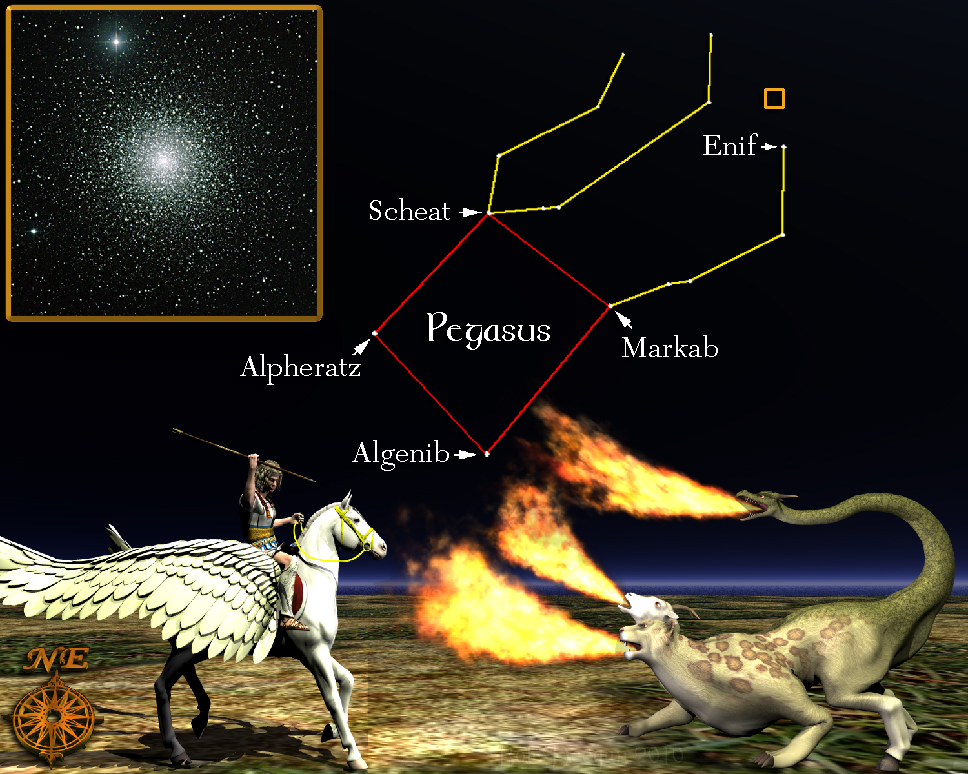
For the week including September 3, 2010

PEGASUS
One of the simple joys of life is to take a walk on a clear dark night and gaze up at the stars. Picking out the constellations though is another thing. People who are just starting out in astronomy can find it a little daunting since there are no easy-to-find borders and outlines among the stars. There are some constellations whose stars make very recognizable patterns and so are fairly easy to learn. One of the best of these is the constellation of Pegasus, the Flying Horse.
In Greek mythology, Pegasus was a winged horse that turned up in more than a few legends. An example of the oldest and most enduring of these stories concerned a young Corinthian prince named Bellerophon. This man’s tales were always about the triumph of virtue over adversity. Once upon a time, Bellerophon had spurned the romantic interests of a haughty queen who, in turn, accused him before her king of having made improper advances. The enraged monarch banished Bellerophon to the kingdom of Lycia. The ruler of that country, Iobates, was secretly asked to provide an “accidental” death for the prince. That accident was easy to arrange. Iobates challenged Bellerophon to rid Lycia of the monster, Chimera. In the 8th century B.C., Hesiod described the Chimera, “who snorted raging fire, a beast great and terrible, and strong and swift-footed. Her heads were three: one was that of a glare-eyed lion, one of a goat, and the third of a snake, a powerful drakon.” Bellerophon accepted the challenge but was at a loss for a way to overcome the creature – previous heroes had gone to the Chimera like marshmallows to a campfire. Some help came from the goddess Athena who appeared to Bellerophon and told him of a spring where Pegasus came to drink. She also gave him a golden bridle that would ensure the horse’s cooperation. Bellerophon staked out the spring and when Pegasus came and bent to drink, he leaped on the horse and slipped the bridle over the horse’s face. Pegasus bucked and reared, but years of equestrian training allowed Bellerophon to stay put. Finally, the winged horse gave in and Bellerophon explained his predicament. Pegasus realized that the best way to get rid of this rude fellow was to assist him in his quest, so off they flew to confront the Chimera. Pegasus, who understood Greek as well as any other winged horse, knew that the name Chimera meant “Icy Breath”, so he was really annoyed at the bad joke when the monster’s first blast singed his wings. After that, the nimble horse danced and flew circles around the beast until strikes from Bellerophon’s lance did him in.
Pegasus made it to the stars, but as legends go, his battle with the Chimera never got great ratings. Over time, people started to think that the Chimera part of the story was all make-believe. There was just something about the “killer goat” head that just got folks sniggering in skepticism. By the first century B.C.E., the orator Cicero wrote, “Who now believes that the Centaurs or the Chimera ever existed? . . . The years obliterate the inventions of the imagination, but confirm the judgments of nature.” Nowadays, the word chimera is used to describe any monstrously unrealistic idea made up of mismatched notions.
As for the stars, if you have a set of binoculars, scan above Enif, the Horse’s Nose, for the wonderful globular star cluster, M15. Shown in the National Optical Astronomy Observatory photograph at upper left and just within naked eye visibility, M15 is one of the densest clusters in our Milky Way galaxy.
Happy Birthday Marty!
Unless otherwise indicated, all content of this web site is the copyright of Robert Deegan and all rights are reserved.
For more information, or to comment, please contact: Bob@NightSkies.org